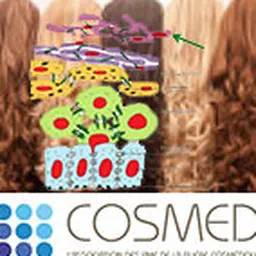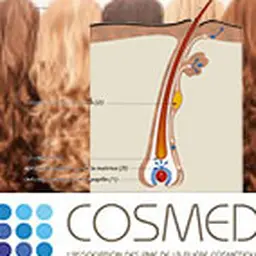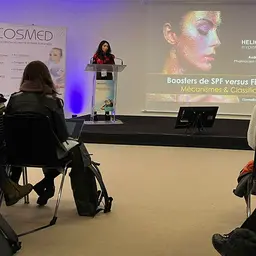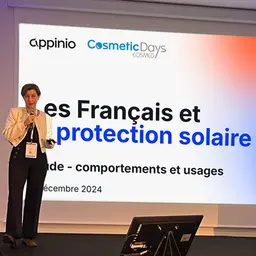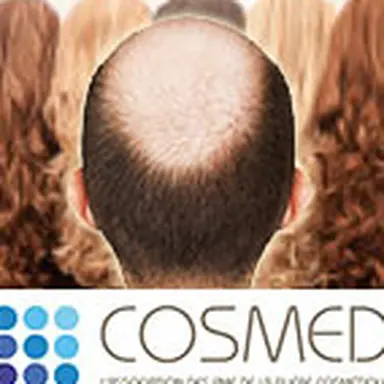
Daily hair loss is normal. But when you lose too much hair, too regularly or all of a sudden, there is a problem. Not all hair loss is caused by the same thing, and treatments vary. At Cosmed's 14th Day of Scientific and Technical Exchanges, Alexandre Guichard, of the Besançon university hospital's dermatology department, reviewed the various kinds of alopecia and the ways to treat them… leaving no room for cosmetic solutions.
Guichard started off by reminding us that dramatic hair loss is never unimportant. Whether it is chronic or acute, it always has a strong impact on the person experiencing it. Hair loss can have an internal cause or be caused by emotional trauma. It is visible and usually has psychological repercussions: women experience it as a loss of femininity and men feel less virile, which can lead to feelings of depression. There is no miracle cure. All of this means that healthcare professionals must be present throughout the process to provide support, but they must never mislead the patient.
Main causes of alopecia
Hair loss is considered abnormal when more than 150 hairs are lost per day. But hair loss can be caused by physiological factors, by pathology, and by alopecia. Loss of hair density is not the same as hair loss.
Technically, alopecia can have a wide variety of causes:
• a problem producing hair: due to a deficiency (martial deficiency), endocrine disorders (dysthyroidism), absorption of toxic substances or certain drugs (chemotherapy) that cause anagen (growth phase) hairs to fall out, resulting in anagen effluvium
• miniaturization, followed by the disappearance of the hair follicle, which causes the hair to thin and then disappear (temporal recession, crown) during AGA (androgenetic alopecia)
• excessive hair loss, usually temporary, caused by premature entry into the telogen phase (the phase where the hair "dies" and falls out) or telogen effluvium
• a problem with the structure of the hair shaft, which can be genetic (hair dysplasia) or acquired (dystrophy, trichotillomania)
• destruction of the hair shaft by keratinophilic infectious agents (ringworm of the scalp)
• an immune response directed against the hair follicle (alopecia areata)
• destruction of the hair follicle of physical, inflammatory, infectious, or tumoural origin, which causes cicatricial (scarring) alopecia.
And all of this can result in reduced hair density that is diffuse or localized, acute or chronic, partial or total. So there is hair loss, and then there is hair loss. Treatment will not always be the same. Guichard pointed out that there are several possible classifications for the different types of alopecia. He suggested one classification and presented the appropriate treatments for each one.
Non-cicatricial alopecia
This is the most frequent form of alopecia. It includes androgenetic alopecia (AGA, or male-pattern baldness), telogen effluvium (TE), and alopecia areata. The common denominator is that the hair follicle and the components required for hair production (matrix, papilla, and bulge) are preserved, but the regeneration cycle is blocked.
Non-cicatricial alopecia can be caused by several processes:
• hormonal disorders (dysthyroidism) or deficiencies (martial, vitamin, trace elements, cachexia) that disrupt the hair growth cycle
• telogen effluvium resulting from stress (fever, psychological stress, surgery, etc.)
• a range of toxins (thallium) and chemotherapies responsible for anagen effluvium
• infections (mycotic folliculitis, also known as ringworm, bacterial folliculitis)
• repeated pulling of hair caused by trichotillomania (obsessive-compulsive disorder) or styling habits (pulling into a bun, intensive brushing, etc.)
• an auto-immune reaction causing follicles to enter the catagen phase, which explains the temporary inhibition of follicles (alopecia areata)
• the regression and miniaturization of hair follicles caused by androgens (AGA), resulting in vellus hair
• in certain areas of the scalp, the hyperactivity of type 2 5α-reductase increases the renewal of hair and the conversion to a vellus follicle.
*For definitions of the various phases in the lifecycle of hair and body hair, see the article entitled 'How well do you know your hair?'.
Androgenetic alopecia
AGA is defined as alopecia caused by the miniaturization of terminal hair, which changes to vellus hair because the hair cycle is accelerated.
There are two phases:
1. Under the action of hormones, the cycles accelerate and the hair does not have time to grow long, thicken, or acquire pigmentation. It becomes a vellus hair (miniaturized) and is no longer visible to the naked eye even if it doesn't fall out.
2. Once a papilla has exhausted its number of cycles (more quickly than normal), the disappearance of the hair is irreversible.
AGA is caused by two concomitant factors:
• androgens: an overexpression of 5α-reductase, which induces an excess of active male hormone
• genetics: a hereditary predisposition of the hair bulbs to be sensitive to hormones, and to testosterone in particular.
It is important to note that the papillae are not all the same with regards to hormones: occipital or lower frontal hair is not very sensitive to androgens, which makes it possible to take hair from these areas and implant it where hair is sparse.
AGA also affects nearly 40% of women over 70 (while it generally sets in much earlier in men) due to an excess of male hormones, which is often accompanied by hirsutism (hair growth in 'masculine' areas: chin, abdomen, etc.).
Treatment
Prescriptions generally involve medicines.
For men: Finasteride, originally a prostate drug, which blocks 5α-reductase, or Minoxidil.
For women: cyproterone acetate (Diane 35) and/or corticosteroids (Spironolactone), Minoxidil, and, optionally, even though it is contraindicated as it can promote breast cancer, Finasteride.
But what about dietary supplements and cosmetics (shampoos, lotions) meant to prevent hair loss? 'They are useless!' declares Guichard. 'AGA must be treated by doctors, not by aestheticians!' This position can undoubtedly be debated by cosmetics professionals. Christophe Ripoll, scientific director at Naturactive, the dietary supplements branch of the Pierre Fabre group, responded by listing several active ingredients that have been proven effective in treating hair loss. For example, he cited pumpkin seed oil and Grateloupia elliptica seaweed, which are able to inhibit the activity of 5α-reductase.
Telogen effluvium
This is the sudden, diffuse loss of a lot of hair, and it occurs most frequently in women.
A triggering factor synchronizes the telogen (death) phase of many hairs at once. Telogen hairs remain on the scalp for two to four months, then they are all shed at once. A cause is often identified in the two to four months preceding the loss of hair. There are two forms of TE: acute (under six months) and chronic (over six months).
The factors causing acute TE include:
• giving birth
• seasonal changes, especially autumn
• psychological shock: death, accident, professional stress, etc.
• bodily stress: high fever, anaesthesia, etc.
• medicines.
The factors causing chronic TE include:
• iron deficiency (which, for Guichard, begins at ferritin levels below 60 ng/ml!!!)
• vitamin deficiencies (e.g. caused by dieting or significant weight loss)
• dysthyroidism
• chronic pathology
• depression
• taking certain medicines
• early signs of AGA, etc.
Chronic TE can also be idiopathic, or it can be the symptom of an undiagnosed pathology.
Treatments
Since TE resolves spontaneously, no treatment is required… at least not for the hair. Doctors must first reassure their patients, making sure they understand that they will not go bald and that this type of hair loss is temporary. It is also important to treat the primary cause by prescribing an antidepressant, treating iron or vitamin deficiencies, monitoring thyroid function, etc.
And cosmetically speaking? Guichard maintains that there are no useful solutions!
Alopecia areata
Alopecia areata is an auto-immune disease in which, in individuals with a genetic predisposition, the immune system attacks the follicle. Hair falls out in large patches, and the condition can either affect certain areas of the scalp only or it can result in complete baldness.
This disease affects 1.7% of all people at least once in their lives. While it is highly visible and psychologically distressing, it is not a serious or contagious condition. Contrary to popular belief, it is not a sign of depression but stress can trigger the condition. It is usually not permanent, but relapses can occur.
Treatments
Efficacy is variable, warns Alexandre Guichard. If no action is taken, the hair will grow back by itself within six months in 60% of the bald patches. In this case, a hair prosthesis and eyebrow tattoos can ease the transition time.
Medical prescriptions can include dermocorticosteroids, triamcinolone acetonide injections, or Minoxidil, but only with the intent to boost spontaneous regrowth. Here, Guichard doesn't even mention dietary supplements or cosmetics.
Cicatricial alopecia
Alopecia is cicatricial when hair is destroyed and replaced with fibrosis (scar tissue). The exact mechanism remains unknown but it would appear that inflammation destroys the papillae.
Cicatricial alopecia is infrequent but can be caused by a wide array of pathologies.
There are three main causes:
• infection, for example by ringworm
• congenital: keratosis pilaris decalvans, incontinentia pigmenti, etc.
• an unknown cause: pseudopelade of Brocq, lupus erythematosus, lichen planus, frontal fibrosing alopecia, Quinquaud's decalvans folliculitis, etc.
Treatment depends on which pathology is causing the alopecia.
Hair dysplasias
Hair dysplasias affect children and are congenital.
The hair is affected by changes in density, structure, shape, and colour, and changes occur in childhood or in the first months of life.
An examination of the hair shaft using a microscope or trichoscope reveals different pathologies: monilethrix, trichorrhexis nodosa, trichorrhexis invaginata (also known as 'bamboo hair'), pili annulati (also called 'ringed hair'), pili torti ('twisted hair'), loose anagen hair syndrome, trichothiodystrophy, uncombable hair syndrome ('pili trianguli et canaliculi'), and woolly hair syndrome.
There is no treatment for these conditions and only non-medicinal options are available:
• transplants
• camouflage with densifying cosmetic powders that use keratin or natural fibres (silk, rice, etc.) that adhere to the hair using static electricity for a temporary increase in volume
• replacement hair that is 'clipped' or sewn onto existing hair or affixed directly to the scalp with natural resin, etc.
In conclusion
'For the time being there are no miracle products,' Guichard reminded us at the end of his presentation. 'Alopecia often has an internal cause and therefore must not be taken lightly. When it affects women, alopecia is not something that beauty salons are equipped to treat; it is a real, internal problem for which a solution must be found. Giving dietary supplements or anti-hair loss shampoos for AGA contributes to the hair loss and to depression!' He warned against 'the false, tempting advertising of the pharmaceutical and cosmetics industries, based on biased or non-clinically significant results'.
The coup de grâce? 'The only treatment that is 100% effective against AGA is acceptance.'

